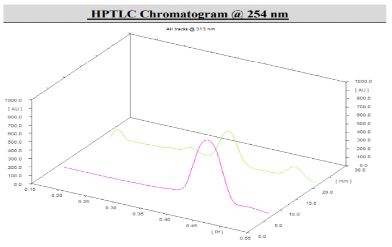Evaluation of Bilva Taila prepared on the principle of Snehapaka through Quality Control Metrics
DOI:
https://doi.org/10.21760/jaims.9.11.16Keywords:
Snehapaka principles, Preliminary analysis, Phyto-chemical screening, Marmelosin quantificationAbstract
The globalization of Ayurveda has led to an increased focus on the standardization and quality control of traditional formulations like Sneha Kalpana. It involves the process of infusing fats with herbal properties to enhance their therapeutic effects. Certain principles were given by Acharya Sharangdhara for the preparation of Sneha Kalpana. Bilva Taila was taken as an example of Sneha Kalpana and two samples were prepared according to the Snehapaka principles by two different references. This study aims to evaluate Snehapaka principle through the quality control metrics of Bilva Taila. The organoleptic characters, physico-chemical parameters, phyto-chemical screening, Marmelosin quantification through HPTLC analysis and heavy metal analysis of raw material i.e. Apakva Shushka Bilva Phala (Unripe Bael fruit powder), Tila Taila (Sesame oil) and finished products (Both the samples of Bilva Taila) were done. The results showed that the pH value for all three samples of Taila was similar, while all other physico-chemical parameters varied between samples. Phyto-chemical screening revealed the presence of various functional group in different samples. Marmelosin quantification also vary in different samples. Heavy metal analysis confirmed that all samples met the permissible limits for lead, arsenic and mercury, indicates the quality and safety for therapeutic use. The study concludes that there is difference found in preliminary analysis, Phyto-chemical screening and marmelosin quantification of both the samples of Bilva Taila prepared on the principle of Snehapaka.
Downloads
References
Sharangdhara, Sharangdhara Samhita of Acharya Sharangdhara, edited by Dr. Smt. Shailaja Srivastava, Madhyam Khanda Ch. 9, Ver.7, Varanasi: Chaukhambha Orientalia, Reprint 2017, p.216
Chakrapani, Chakradatta of Acharya Chakradatta, edited by Dr. Indradeva Tripathi, Ch. 57, Ver. 29, Varanasi: Chaukamba Sanskrit Bhawan, Reprint 2019. p.339
Sharangdhara, Sharangdhara Samhita of Acharya Sharangdhara, edited by Dr. Smt. Shailaja Srivastava, Madhyam Khanda Ch. 9, Ver.174, Varanasi: Chaukhambha Orientalia, Reprint 2017, p.238
Chakrapani, Chakradatta of Acharya Chakradatta, edited by Dr. Indradeva Tripathi, Ch. 57, Ver. 29, Varanasi: Chaukamba Sanskrit Bhawan, Reprint 2019. p.339
Sharangdhara, Sharangdhara Samhita of Acharya Sharangdhara, edited by Dr. Smt. Shailaja Srivastava, Madhyam Khanda Ch. 9, Ver.174, Varanasi: Chaukhambha Orientalia, Reprint 2017, p.238
Anonymous, The Ayurvedic Pharmacopoeia of India, Part-1, Volume-1, Appendix 2 First Edition, New Delhi: Government of India, Ministry of Health and Family Welfare, Department of AYUSH; 2009; p.213
Anonymous, Laboratory guide for the analysis of Ayurveda and Siddha formulation, First Edition, New Delhi: GOI, Central council for research in Ayurvedic sciences, Ministry of AYUSH, 2010, pg. 27
Anonymous, The Ayurvedic Pharmacopoeia of India, Part-1, Volume-1, Appendix 2 First Edition, New Delhi: Government of India, Ministry of Health and Family Welfare, Department of AYUSH; 2009;160
Anonymous, The Ayurvedic Pharmacopoeia of India, Part-1, Volume-1, Appendix 2 First Edition, New Delhi: Government of India, Ministry of Health and Family Welfare, Department of AYUSH; 2009; p.160
Anonymous, Laboratory guide for the analysis of Ayurveda and Siddha formulation, First Edition, New Delhi: GOI, Central council for research in Ayurvedic sciences, Ministry of AYUSH, 2010, p.28
Anonymous, Laboratory guide for the analysis of Ayurveda and Siddha formulation, First Edition, New Delhi: GOI, Central council for research in Ayurvedic sciences, Ministry of AYUSH, 2010, p.28
Anonymous, The Ayurvedic Pharmacopoeia of India, Part-1, Volume-1, Appendix 2 First Edition, New Delhi: Government of India, Ministry of Health and Family Welfare, Department of AYUSH; 2009; p. 297
Anonymous, The Ayurvedic Pharmacopoeia of India, Part-1, Volume-1, Appendix 2 First Edition, New Delhi: Government of India, Ministry of Health and Family Welfare, Department of AYUSH; 2009; p. 212
Anonymous, The Ayurvedic Pharmacopoeia of India, Part-1, Volume-1, Appendix 2 First Edition, New Delhi: Government of India, Ministry of Health and Family Welfare, Department of AYUSH; 2009; p. 223
Anonymous, The Ayurvedic Pharmacopoeia of India, Part-1, Volume-1, Appendix 2 First Edition, New Delhi: Government of India, Ministry of Health and Family Welfare, Department of AYUSH; 2009; p. 221
Anonymous, The Ayurvedic Pharmacopoeia of India, Part-1, Volume-1, Appendix 2 First Edition, New Delhi: Government of India, Ministry of Health and Family Welfare, Department of AYUSH; 2009; p. 212
Anonymous, The Ayurvedic Pharmacopoeia of India, Part-1, Volume-1, Appendix 2 First Edition, New Delhi: Government of India, Ministry of Health and Family Welfare, Department of AYUSH; 2009; p. 222
Anonymous, The Ayurvedic Pharmacopoeia of India, Part-1, Volume-1, Appendix 2 First Edition, New Delhi: Government of India, Ministry of Health and Family Welfare, Department of AYUSH; 2009; p.300
Baxi A. J. Shukla V. J., Bhatt U. B. methods of qualitative testing of some Ayurvedic formulation, June- 2001.
Medicinal plant alkaloids by Sim Stephen K., University of Torronto press,1969; p.144
Anonymous, The Ayurvedic Pharmacopoeia of India, Part-1, Volume-1, Appendix 2 First Edition, New Delhi: Government of India, Ministry of Health and Family Welfare, Department of AYUSH; 2009;178
https://ciah.icar.gov.in/publication/Technical_bulletin/2018/bael_production_technology.pdf
Vipul Chaudhary et. al; Drying characteristics of Bael pulp using different drying methods and different varieties, International journal of Agricultural engineering, vol. 13(1), 2020, p. 19-30
Houghton, P.J et. al,). The Role of Moisture Content in Herbal Powder Quality, Journal of Herbal Pharmacotherapy, vol.2(3), 2002, p. 27-38
Anonymous, The Ayurvedic pharmacopoeia of India, part-I, vol.-1, 1st edition, 2008, Published by Govt of India, Ministry of Health and Family welfare, Dept of Ayush, New Delhi p.136
https://labmonk.com/determination-of-ash-value-of-given-sample
Anonymous, The Ayurvedic pharmacopoeia of India, part-I, vol.-1, 1st edition, 2008, Published by Govt of India, Ministry of Health and Family welfare, Dept of Ayush, New Delhi p.136
https://labmonk.com/determination-of-ash-value-of-given-sample
Anonymous, The Ayurvedic pharmacopoeia of India, part-I, vol.-1, 1st edition, 2008, Published by Govt of India, Ministry of Health and Family welfare, Dept of Ayush, New Delhi p.136
Anonymous, The Ayurvedic pharmacopoeia of India, part-I, vol.-1, 1st edition, 2008, Published by Govt of India, Ministry of Health and Family welfare, Dept of Ayush, New Delhi p.136
Silpa M et.al, a phytochemical study on eupatorium glandulosum. Asian Journal of Pharmaceutical and Clinical Research, vol. 13/1, Jan 2020, p. 77-80
Paul et.al; Extraction and Characterization of Oil from Sesame Seed, Research Journal of Pharmaceutical, Biological and Chemical Sciences, vol.4(2), 2013, p.752-757
Proksch, E.et. al, The skin: an indispensable barrier. Experimental Dermatology, vol.17(12), 2008, p. 1063-1072
Vira et. al; Characteristics, Extraction, Purification, and the Recent Applications of Sesame Oil in Food Products, International Journal of Emerging Trends in Engineering Research, vol. 8(10), p. 7692-7698
C. B. L. Ghosh, Viscosity and its effect on the penetration of topical formulations, International Journal of Pharmaceutics, vol. 370(1-2), 2009, p.36-42
Anonymous, The Ayurvedic pharmacopoeia of India, part-I, vol.-5, 1st edition, 2008, Published by Govt of India, Ministry of Health and Family welfare, Dept of Ayush, New Delhi p.147
Tontodonati, N. et. al, Assessment of the quality of edible oils by refractive index and other physicochemical parameters. Journal of the American Oil Chemists Society, vol. 80(12), 2003, p.1113-1116
M. A. A. Alirezaei, Assessment of oil quality through acid value and free fatty acids measurement, Journal of the American Oil Chemists Society, vol. 87(8), 2010, p. 883-890
Anonymous, The Ayurvedic pharmacopoeia of India, part-I, vol.-5, 1st edition, 2008, Published by Govt of India, Ministry of Health and Family welfare, Dept of Ayush, New Delhi p.147
Paul et.al; Extraction and Characterization of Oil from Sesame Seed, Research Journal of Pharmaceutical, Biological and Chemical Sciences, vol.4(2), 2013, p.752-757
Rahman Akinoso et. al: Effects Of Moisture Content And Heat Treatment On Peroxide Value And Oxidative Stability Of Un-Refined Sesame Oil, African Journal of Food Agriculture Nutrition and Development, vol.10(10), 2010, p.4314
Frankel, E.N., Oxidative stability of fats and oils: Measurement and significance, Journal of the American Oil Chemists' Society, vol.57(1), 1980, p. 7-11
D. J. McClements, The Role of Lipids in the Absorption of Nutrients," Critical Reviews in Food Science and Nutrition, vol. 56(3), 2016, p.313-328
Anonymous, The Ayurvedic pharmacopoeia of India, part-I, vol.-5, 1st edition, 2008, Published by Govt of India, Ministry of Health and Family welfare, Dept of Ayush, New Delhi p.147
O.o. Olaleye et. al; Extraction, Physicochemical and Phytochemical Characterization of Oil from Sesame Seed, Asian food science journal, vol.1(4), p.1-12
Parvez, M.K., et al, Short-chain fatty acids: Potential for the prevention and treatment of inflammatory diseases, Nutrition Reviews, 77(4), 2019, p.245-260
R. A. E. de Souza, et al., Unsaturated fatty acids: A review on their properties and health benefits." Nutrition Reviews, vol.73(3), 2015, p. 185-198
Anonymous, The Ayurvedic pharmacopoeia of India, part-I, vol.-5, 1st edition, 2008, Published by Govt of India, Ministry of Health and Family welfare, Dept of Ayush, New Delhi p.147
Ghosh M. et. al, Phytochemical extraction: A review of methods and applications. Journal of Pharmacognosy and Phytochemistry, vol.8(3), 2019, p.1945-1952
B. M. A. F. C. S, Thermal degradation of phenolic compounds, Food Chemistry, vol. 98(3), 2006, p.473-482















